Apple's Mac Pro - Upgrading CPUs, Memory & Running XP
by Anand Lal Shimpi on September 12, 2006 1:51 AM EST- Posted in
- Mac
Upgrading the Mac Pro's CPU
Now that Apple has completed the switch to Intel based processors, upgrading your CPU is a much cheaper and more accessible option for Mac users. In the past, upgrading your CPU required visiting an Apple specific vendor and paying quite a bit for a processor since the demand was honestly quite low. Now, with the Mac Pro and any other Intel based Mac that has a socketed processor an upgrade is just as easy as a trip to Newegg.
The Mac Pro we ordered was the slowest 2.0GHz configuration, since we wanted to try and upgrade it to faster parts to see if it was possible. By opting for the slowest CPUs, you can buy a cheaper overall computer and simply throw in faster CPUs once they drop in price - assuming the upgrades work of course.
By far the biggest problem with upgrading the CPUs in the Mac Pro is gaining access to them. While Apple made it very easy to upgrade memory, storage and PCIe cards in the Mac Pro, getting access to the CPUs is considerably more difficult. The entire process would be made much easier if we were able to remove the memory cage, but as we mentioned in our last article the standoffs that the cage is screwed into would not remain in place while we unscrewed the cage. To make a long story short, we weren't able to remove the memory cage without stripping the screws that held it in place, so we had to come up with an alternative solution; luckily we were able to do just that.
The first step is to remove the heatsink cover, which has latches along its sides that the fan assembly and part of the memory cage hook up to. With the memory cage in place, your only option is to pull back on the memory cage to unlatch it from the heatsink cover and slowly pull/rotate the cover off. This process is made somewhat easier by removing the two screws that attach the memory cage to the motherboard, since it allows the cage to move a little more freely. Obviously you'll want to remove both memory risers before doing this, but simply pulling the cage back towards the rear of the case and pushing the heatsink cover in the opposite direction should let you unlatch it.
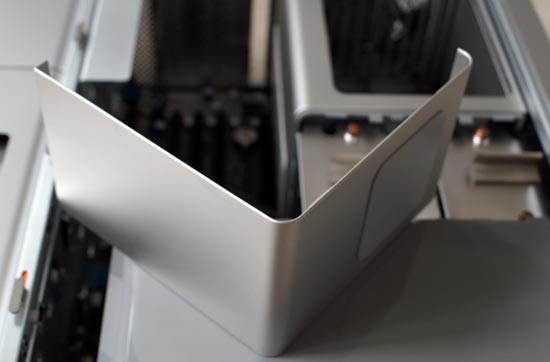
With the memory side of the heatsink cover unlatched, simply pull it away from the fan assembly being careful not to break the latches. After you've done this, the Xeon heatsinks should be exposed.


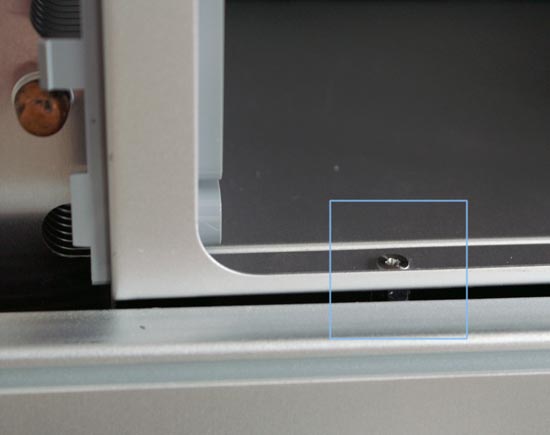
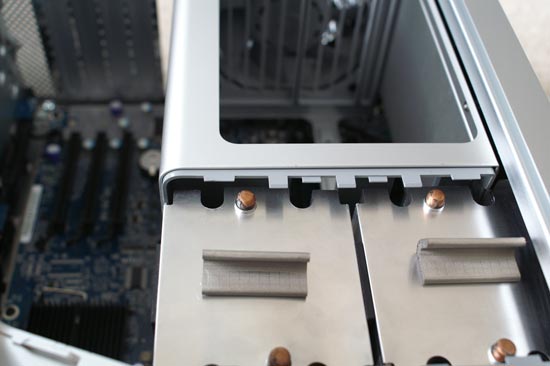
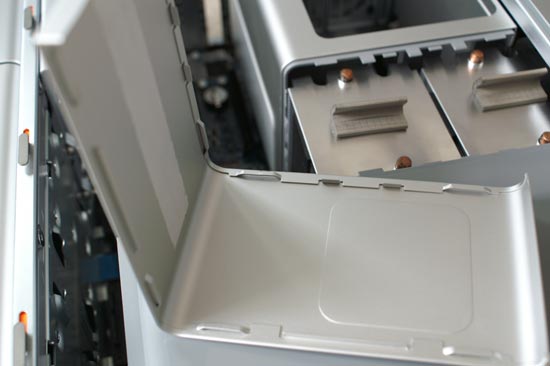
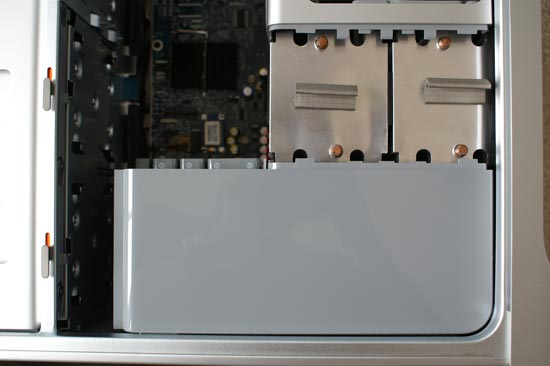








72 Comments
View All Comments
Calin - Tuesday, September 12, 2006 - link
Assuming you want a workstation capable of accessing 16GB of RAM (and using two processors), your options are a bit more reduced. There was an article on Anandtech, and the Mac Pro (the most expensive) was just a couple of hundred dollars more expensive than the sum of its components (and operating system I think).tuteja1986 - Tuesday, September 12, 2006 - link
Intel Xeon 5150 2.66Ghz1GB PC2-5300 DDR2
250GB 7200RPM Sata-II
16x DVDRW
7300GT
Good Looking Case
Server Mobo
Mac OS
$2499
vs
Intel Xeon 5150 2.66Ghz $729
3x 250GB Western Digital in raid 5 $65 each = $195
Pionere 110D = $50
7900GT $260
2x 1GBx2 OCZ PC2-5300 $200 each = $400
TYAN S5370G2NR-RS Dual Socket 771 Intel 5000V SSI CEB Server Motherboard $319 supports 16GB ram
Cool Master Stacker $154
Rosewill RP600V2-S-SL 600W SLI Ready $70
Linux OS , Microsoft Windows XP Professional X64 Edition Single Pack $139
$2316
I know what i will pick :!
grtgrfx - Monday, December 21, 2009 - link
And which one will run cooler and be completely silent when you push it? Ah, the Mac will. High quality build, excellent components, superior GUI: $2,500. Peace and quiet while working: priceless.Nimbo - Tuesday, September 12, 2006 - link
Anand did compare prices in its second article about Mac prohttp://www.anandtech.com/showdoc.aspx?i=2816&p...">http://www.anandtech.com/showdoc.aspx?i=2816&p...
Mac Pro: $2499
Dell equivalent: $3110
Home Built: $2390
tuteja1986 - Wednesday, September 13, 2006 - link
MAC PRO $2499
Two 2.66GHz Dual-Core Intel Xeon
1GB (2 x 512MB)
250GB 7200-rpm Serial ATA 3Gb/s
NVIDIA GeForce 7300 GT 256MB (single-link DVI/dual-link DVI)
One 16x SuperDrive
Apple Keyboard and Mighty Mouse - U.S. English
Mac OS X - U.S. English
- not include :
Server OSX
Monitor
Modem
Fiber Channel Cards
Wireless Option
Any Apple Software
Or even Apple Care Protection Plan (APP)
Now if your doing loads of Video Editing/encoding.. one Gigabyte ram is crap all and 1 250GB is to little...
Two 2.66GHz Dual-Core Intel Xeon
4GB (4 x 1GB)
500GB 7200-rpm Serial ATA 3Gb/s
500GB 7200-rpm Serial ATA 3Gb/s
500GB 7200-rpm Serial ATA 3Gb/s
ATI Radeon X1900 XT 512MB (2 x dual-link DVI)
One 16x SuperDrive
Apple Wireless Keyboard and Apple wireless Mighty Mouse - U.S. English
Mac OS X - U.S. English
$4,909.00
- not include :
Server OSX
Monitor
Modem
Fiber Channel Cards
Wireless Option
Any Apple Software
Or even Apple Care Protection Plan (APP)
At Mac Customize they don't give you a chose of additional 250GB hard drive just 500GB Hard drive
Now Windows/Linux PC is where it shins :
Intel Xeon 5150 Woodcrest $729 : $1458
Western Digital Caviar SE16 WD5000KS 500GB 7200 RPM SATA 3.0Gb x3 $189 = $567
HIS/Sapphire/Asus Radeon X1900XT 256MB GDDR3 PCI Express x16 CrossFire Video Card - $300-$320 could way more cheaper with rebate
NEC/LG/Sony/Lite-on 16X DVD±R DVD Burner Beige IDE Model ND-3550A $30
hermaltake Armor Series VA8000BWS Black Computer Case - Retail $149
Rosewill RP600V2-S-SL 600W SLI Ready $70
Logitech Cordless DesktopS Keyboard Mouse $58
Creative Sound Blaster $40
Windows XP PRO 64bit $139
TYAN S5370G2NR-RS Dual Socket 771 Intel 5000V SSI CEB Server Motherboard $320
Crucial Technology 1GB 240-Pin DDR2 FB-DIMM DDR2 667 $170 x 4 = $680
$3811USD
tech010101x - Wednesday, September 13, 2006 - link
You do realize that the Mac Pro comes with all the drive sleds... you can add the WD5000KS drives yourself later. You can also add memory yourself.Doing it this way... ordering the Mac Pro with 2 x 512MB RAM and 1 500GB drive costs: $3009.
Add in the RAM you quote: 4 DIMMS at $680 + 2 WD5000KS at $189 @ = $4067
Total difference then is a mere $256.
You are still missing firewire 400 and 800 and firewire target disk mode.
The power supply in the Mac Pro is much beefier.
Windows XP 64 bit is a mess.
And then we get to the fact that you are comparing a retail price to a non-retail price, comparing a bunch of parts to a fully assembled system, and you are leaving out the shipping issue altogether. Certainly, it is possible to pay $4,909 + tax for the Mac Pro. It is also very possible to pay far less.
The arguments in this regard are less about Apple and more about homebuilt vs. Tier 1 vendor. You might as well be comparing against IBM Intellistations, Sun Ultra 40's, or HP xw8400's. You'd appreciate it not being a homebuilt when you have to manage many of these over time.
A 5% discount on the base system + the extra RAM and drives added later is $3917, or $106 difference. I usually get bigger discounts than that 5% on systems like this.
In the end, if you aren't interested in using Mac OS X at all, the Mac Pro is probably not for you. It is the complete suite... from the hardware (including the nice boot menu, target disk mode, etc), the software (Mac OS X, iLife, platform user experience, etc.), solutions integration (Xsan costs $999 vs. ADIC StorNext at $4k for SAN filesystems), on through to applications (Final Cut Studio, Shake, etc.).
Calin - Wednesday, September 13, 2006 - link
Windows XP Professional supports two processors (cores) out of the box. Put a Windows 2003, and see where you get...Sunrise089 - Tuesday, September 12, 2006 - link
and even that "home built" price was without a case, OS, or power supply.Calin - Wednesday, September 13, 2006 - link
As for the OS, you could "migrate" your Windows XP - with one small problem - XP is 1-2 processors only, this configuration would have 4 cores...So, add another ... for Windows 2003
JarredWalton - Wednesday, September 13, 2006 - link
Sorry, but that's wrong. XP is 1-2 *sockets* only. XP home will work with a dual core or even quad core CPU just fine, and XP Pro works with all 2S workstation setups without difficulty. Microsoft modified the way they count CPUs when dual core first came out.